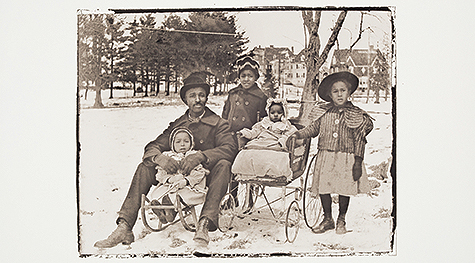
Photographs are a tangible reminder of the past. They serve as both evidence and reassurance that there was life before our own.
Worcester today is a diverse city with groups of people from all over the world. However, when most picture life 100 years ago, they may fail to acknowledge the existence of minority groups within their own town. Therefore, the uniqueness in Worcester Art Museum’s recent exhibit, Rediscovering an American Community of Color: The Photographs of William Bullard, on display through February, is one that is worth a visit.
The exhibit features photographs by William Bullard, a white itinerant photographer born in 1876 who resided in the Beaver Brook community in Worcester. Though he never had his own studio, that didn’t stop him from treating his hobby as a job. Due to the inability to develop these photos, his collection remained as negatives for 100 years. By the time of his death in 1918, a total of 5,400 glass negatives were left behind, 80 which have been featured in this exhibit. The photographs range from 1897-1918, presenting African and Native Americans from the Worcester Beaver Brook community.
Bullard was able to save money and fund his hobby by living in a boarding house that his mother hosted. He even received compensation for some of the pictures he took. The current owner of these photographs, Frank Morrill, of Charlton, bought these negatives with the impression that they would illustrate the corner stores and streets of Worcester during that time. He never realized there would be about 200 photos of the Beaver Brook people of color (POC) community.
The revelation came as a surprise, since racial tension was prominent at that point in time. Even today, no one knows why Bullard had a fascination in photographing POC during such an unlikely period.
Morrill teamed up with Janette Greenwood, Clark University historian, as well as Nancy Burns, the museum’s associate curator of prints, drawings and photographs, to help bring this exhibit to life.
Bullard kept a logbook of the names of those he photographed, which allowed Morrill, Greenwood and Burns to identify 80 percent of the people starring in his collection. “We were able to research into their lives and find their story,” Greenwood said.
One family in particular is represented many times in Bullard’s photos; the Perkins family had more than 36 photographs taken. Other pictures are made up of families, couples and children simply living in their neighborhoods. Most are shown in rather fashionable clothes, defeating the stereotypes.
“Very few people have images of their ancestors over 100 years. This is particularly true for POC and lower-income residents,” said Greenwood. “It’s important that we are able to tell a story for POC. It’s a very personal and emotional thing.”
Clark University plays a significant role in the research and funding of this distinctive exhibit. Greenwood and Burns co-taught a seminar at Clark called Public History: Race, Photography and Community, in spring 2017, which gave students the opportunity to be active in the creation of a new website that will present all of the photographs from the museum in digital format. The images will remain as an irreplaceable treasure for generations to witness.
Rediscovering an American
Community of Color:
The Photographs of William Bullard
Worcester Art Museum
55 Salisbury St., Worcester
through Feb. 25
For more information, visit worcesterart.org. To scroll through the archive, visit bullardphotos.org.
– Jennifer MICHAUD





